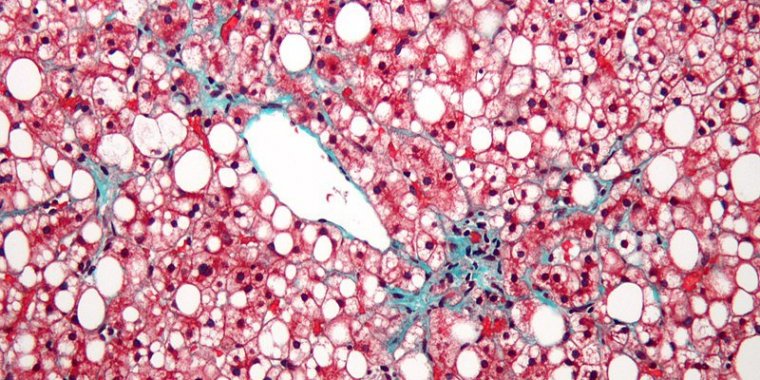| Health / Health News |
High-Fat, High-Sugar Diet Causes Lasting Harmful Effects on Liver
For a new study, the investigators developed a nanosensor that can detect and noninvasively track the accumulation of fat in the liver. They used the sensor to assess the effects of a high-fat, high-sugar diet on the livers of mice. They then evaluated the outcomes when the mice returned to a healthy diet. Unexpectedly, the researchers found that, while the fat accumulation decreases after returning to a healthy diet, some residual fat remains in certain liver cells long afterwards.

Non-alcoholic fatty liver disease (NAFLD). The liver has a prominent (centrilobular) macrovesicular steatosis (white/clear round/oval spaces) and mild fibrosis (green). The hepatocytes stain red. ![]()
Patients with nonalcoholic fatty liver disease (NAFLD) develop an accumulation of excess fat in their livers. The condition can progress to a more serious disease involving inflammation, scarring and even liver cancer (called nonalcoholic steatohepatitis, or NASH).
People who accumulate fat inside liver cells called Kupffer cells, specifically a part of these cells named lysosomes that act like cellular garbage collectors, appear more likely to progress to serious liver disease.
Currently, some imaging tools like ultrasound or magnetic resonance imaging can help identify people with fatty livers, but these techniques often provide less detailed information.
This nanosensor is the first to noninvasively detect fat in the lysosomes of the Kupffer cells, potentially identifying those most at risk of progressing.
The tiny sensor is about 1,000 times smaller than the width of a human hair and made of single-stranded DNA wrapped around a single-walled carbon nanotube. Fat accumulation in the lysosomes changes the color of light emitted by the nanosensor.
When the nanosensors are injected into a mouse, the liver filters them out of the blood and then are consumed by the organ's lysosomes.
Shining a near-infrared flashlight-like device on rodents injected with these nanosensors causes the sensors to glow. The color of the light corresponds to the fat content in the liver, allowing scientists to measure fat non-invasively using the device. (Tasnim News Agency)
YOU MAY ALSO LIKE

